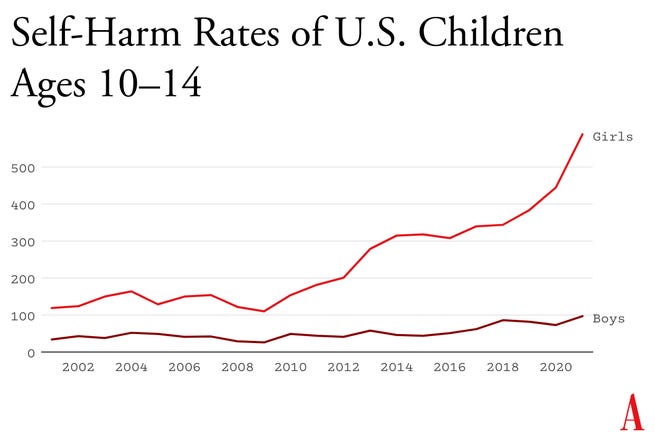Note: this post is part of a series of newsletters I’m writing that’s devoted to the subject of kids and phones. If you know someone who might be interested in it, I’d love if you could share it. If you are *not* interested in receiving future emails on kids and phones, you can unsubscribe from just this section (while remaining part of the general “How to Feel Alive” list) by adjusting your Substack settings.
Hi all,
I’m freshly back from a week in Puerto Rico for my daughter’s spring break, where I did fun things like rediscover that, unlike Ken, I don’t know how to “beach,” and that unlike nearly everyone else I know, I am unable to read novels to relax.
So instead, I covered myself in sun-protective clothing and SPF 50 sunblock and immersed myself in my version of a light beach read: social psychologist Jonathan Haidt’s new book, The Anxious Generation: How the Great Rewiring of Childhood is Causing an Epidemic of Mental Illness.
I first came across Haidt’s work years ago, via his book, The Happiness Hypothesis, when I first started writing about what it takes to live a meaningful and joyful life. These days, he’s the main author (along with
) of the excellent Substack newsletterAfter Babel—which I highly recommend subscribing to if you have any interest in the issue of kids and technology. The Anxious Generation, which you likely have heard of, because it is (thankfully) everywhere right now, is about kids, smartphones, social media, and mental health—and what to do about all of the above.I had the chance to meet Jon personally at an event last year, at which he gave a preview of some of arguments and suggestions from the book, and it got me all fired up in an “Oh my goodness, maybe there’s hope for our kids yet!” kind of way. Now that the book is out, I’m happy to say that it delivers. In it, Jon presents compelling evidence that the advent of smartphones and social media has had absolutely devastating effects on the mental health of young people, particularly girls — and makes the argument that today’s youth mental health crisis (which is not limited to the United States) is largely the result of what he calls the decline of “play-based” childhood, and its replacement with “phone-based childhood.”

His book contains the most thorough and convincing roundup and analysis of the research that I’ve seen. (He goes through much of this in his recent piece for the Atlantic; you can also learn about it by reading this post.)
But—and this is important!—Haidt doesn’t just talk about the problem. He presents a solution, in the form of simple, evidence-backed suggestions for schools, parents, teachers, and legislators that, if collectively adopted, could create a cultural shift that could end the era of the phone-based childhood and protect our children’s mental health.
I’m intending to mobilize other parents at my daughter’s school and enact some of Haidt’s suggestions, and I invite you to join me.
The General Plan:
Here are Haidt’s four suggestions for how we can protect and support our kids (quoted verbatim, with my notes in brackets):
1. More unsupervised play and childhood independence. That’s the way children naturally develop social skills, overcome anxiety, and become self-governing young adults.
2. No smartphones before high school. Parents should delay children’s entry into round-the-clock internet access by giving only basic phones (phones with limited apps and no internet browser)* until [at least] 9th grade (roughly age 14).
3. No social media before [at least] 16. Let kids get through the most vulnerable period of brain development before connecting them to a firehose of social comparison and algorithmically chosen influencers.
4. Phone-free schools. In all schools from elementary through high school, students should store their phones, smartwatches, and any other personal devices that can send or receive texts in phone lockers or locked pouches during the school day. That is the only way to free up their attention for each other and for their teachers.
*Note: There are an increasing number of smartphone alternatives available—check out my round-up of smartphone alternatives for examples. Also, if your child already has a smartphone, you may want to consider paying for an add-on parental control plan from your service provider (I link to a few in the round-up) — they often provide the ability to set schedules and block particular apps, and are way more robust than what is natively available in the apps or on your phone.
Also, just to acknowledge the obvious: technology is an essential part of modern life, and teenagers are understandably going to want to be able to communicate with their peers—but there are ways to do this without social media. I’ll get into this in more detail in future newsletters.
Times have changed
There was a time, not so long ago, when Haidt’s proposed solutions might have seemed far-fetched. (I remember those days, because that’s what the world was like when How to Break Up With Your Phone came out in 2018!) But even in the past few months, attitudes have changed. The United States Surgeon General, the American Academy of Pediatrics, the American Psychological Association, the Centers for Disease Control and Prevention, and the World Health Organization have all issued advisories or guidance documents about phones and screens. The United Nations has called for schools around the world to ban phones from classrooms, and countries including the U.K., France, Italy, Finland and the Netherlands, have done just that. Even in countries without mandatory bans, administrators have enacted restrictions, and parents are joining together to sign pledges promising not to get their children smartphones or allow them onto social media until high school (or beyond). In the United States, lawmakers from both parties are working together (!!!!!) to try to update the Children’s Online Privacy Protection Rule (COPPA) to raise the age of consent for kids to sign up for social media accounts from 13 to at least 16 (more details here)—and actually require companies to enforce it. In other words, momentum is growing.
It takes collective action
One of the challenges that has always been present, when it comes to kids, phones, and social media, is that any change has to be collective in order for it to be successful. In other words, yes, you technically could forbid your child from having a smartphone or social media account, but if all of their other friends have phones and social media accounts, it’s going to be very, very hard. You might protect them from some of the negative effects of the platforms, but your kid will be correct when they say that they’re being left out—and the adolescent brain is particularly sensitive to social exclusion by peers.
However, if everyone (or even just a substantial portion of parents) agreed to follow Haidt’s suggestions, it would be a different story: if your kids’ friends aren’t on social media, then there’s less pressure for them to be. That’s the idea behind the Wait Till 8th movement in the United States and Smartphone-Free Childhood in the UK, both of which offer resources and support for parents who are up for the challenge of taking a stand against phone-based childhood. Haidt and his colleagues have also put together an excellent site, FreeTheAnxiousGeneration.com, that compiles research and resources; I also recommend
’s Substack, “Be ScreenStrong.”Will you join me?
My own daughter is in 3rd grade; next year she’ll be in a combined class of 4th and 5th graders, which means that this issue is very much at the front of my mind (by that, I mean it literally keeps me up at night). As I mentioned above, I am planning to invite other parents at her school to join me and my husband in committing to not getting our children smartphones until they are in at least high school, or allowing them onto social media until they are at least 16. (I think that these age targets are better, based on adolescent brain-development, than only waiting till 8th grade, though the writer in me does appreciate the rhyme.)
Will this be easy? No. Will there be pushback? Possibly. Will it make me feel very self-conscious and awkward and nervous to put myself out there like this? Yes! (I know that I literally wrote a book about the need to redefine our relationships with technology, but that doesn’t mean that I relish the idea of being responsible for leading a movement.)
But here’s something I know: I need to do this. We need to do this. And so I’m pushing my own shyness and self-consciousness aside, and am going to take action—for my daughter, and for all the other kids in her generation. And I hope that you’ll join me.
If you’re in—or even if you’re just curious about the idea—please leave a comment below indicating your support, so that we can all see that we’re not alone (and if you have any experience initiating a similar movement in your own children’s school, definitely leave a comment, and share advice!). Over the coming months, I’ll keep you posted on my own progress, and share any insights that I’ve learned.
To scrolling less and living more—and helping our children to do the same,
Catherine
Additional Resources
If you would like to learn more about Haidt’s research, advice, and conclusions, he has an excellent piece in the Atlantic summarizing the book’s arguments, and here is a Q&A he did withDavid Epstein for his Substack, Range Widely. Also be sure to subscribe to Haidt’s Substack, After Babel. You may also want to check out the work of
, author of the Generation Tech Substack, who wrote an article back in 2017 called “Have Smartphones Destroyed a Generation?” (and a book called iGen) and has been way ahead of the curve in recognizing the severity of this issue. Lastly, “Be Screen Strong” by , and by Jacqueline Nesi are all Substacks that address issues related to kids and tech. I also love ’s Substack,“The Analog Family.”PS: Next week, I’ll be getting back to the subject of Fun at Work, with my fellow fun-stigator, Devin McNulty. Many thanks to Fun Squad members who have shared their work challenges—I can’t wait to hear what Devin has to say!






One thing that interests me about social media and younger kids is how it continues to be perceived. Social media is deeeeply uncool to my 6th grader. It would be embarrassing to have an account! Only the ancients (that would be us parents) and obnoxious try-hards are on social media. I am mocked for rotting my brain if he catches me watching reels, which I find amusing. Let me watch someone pressure washing a driveway in peace while I wait for you to finish brushing your teeth!!
We'll see how that goes as he gets older. He does have a smartphone and we have rules for it that are not difficult to manage. And our schools have a strict no phones/smartwatches out policy. It's been a good tool to go hand in hand with unsupervised play and independence at this age, when he is able to branch out farther and farther from home. But that's our experience and coming from me who uses my phone/social media to boost my offline activities and community building.
Not so fun fact: when my friends who have children give their children unsupervised play, they have no idea what to do! This is a problem from the top down -- if the parents are going to model phone use and don't model how to have fun without their phones, then unsupervised play isn't going to work in my opinion.